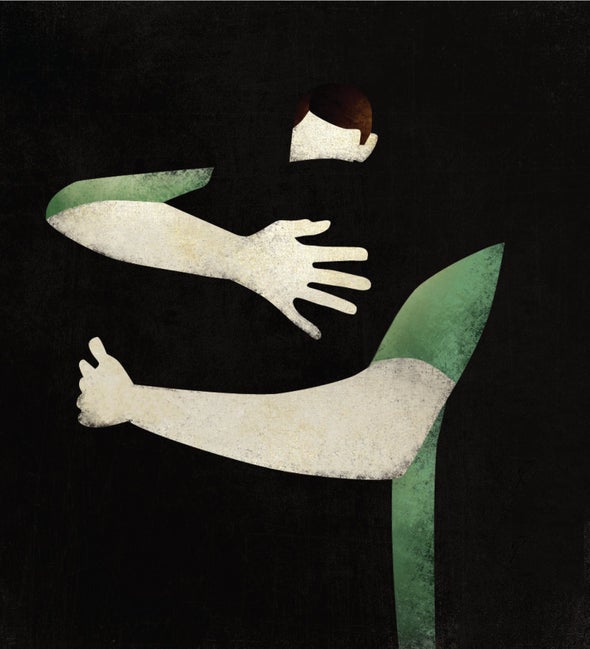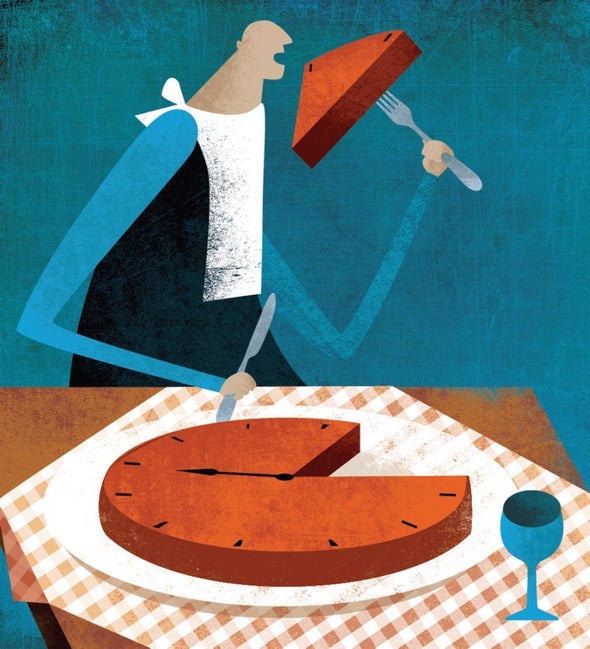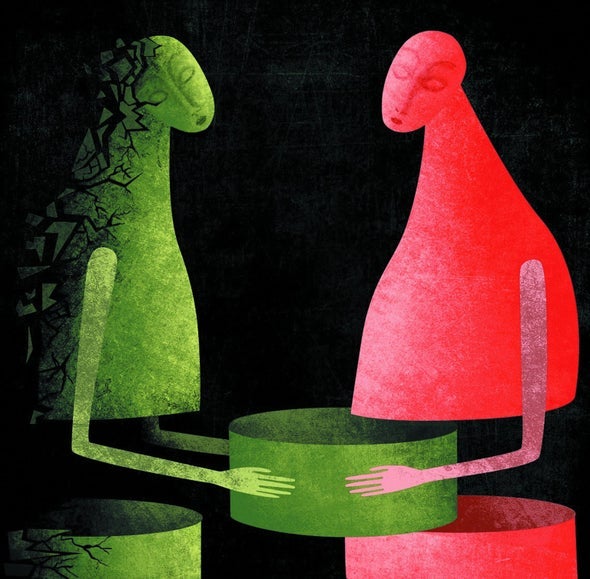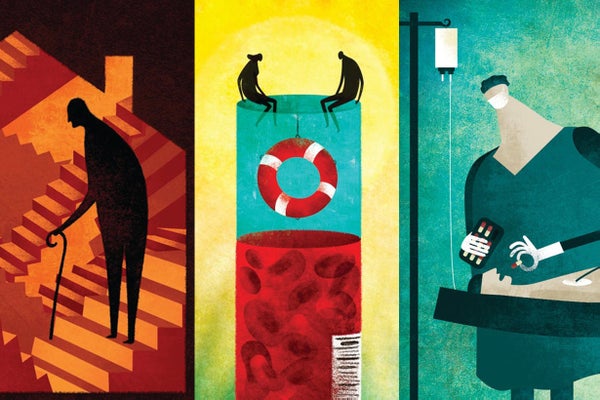Many view the scientific process as a tool to preclude human emotions from influencing the search for truth. But those emotions are essential when it comes time to help people connect to the science, or so suggests award-winning illustrator and visual artist Fatinha Ramos. The Portuguese artist has won awards from the Society of Illustrators NY, 3x3, Global Illustration Award and World Illustration Awards, to name a few. Her most recent win, the overall professional award from the World Illustration Awards, came for her illustration “Another Tragic Epidemic: Suicide,” which was published in Scientific American.
Though Ramos’ illustrations span a variety of themes, she has created art for numerous stories about science, including articles on topics such as novel methamphetamine addiction treatments, organ donations from terminally ill patients, and rising numbers of suicides. Her style, which is recognizable by its handmade textures and vibrant colors, imbues her creations with intimacy and warmth.
Scientific American sat down with Ramos to talk about the craft of science illustration, her approach to creating artwork for scientific stories and how she formulated her (most recent) award-winning piece.
On supporting science journalism
If you're enjoying this article, consider supporting our award-winning journalism by subscribing. By purchasing a subscription you are helping to ensure the future of impactful stories about the discoveries and ideas shaping our world today.
How would you describe your job of a science illustrator?
What I try to do is translate a concept from a story into something visual that people from different backgrounds can understand. So that when people open the article, they can more or less see what it is about and relate with the title.
Do you have any other objectives in mind when creating your science illustrations?
My main target with any illustration I do is to strike an emotional chord with people. I want to touch people with my illustrations, even though these are scientific things in scientific fields.
You also illustrate topics outside the realm of science. What’s different about creating art for science stories?
It’s different because with other types of stories I may not need to look very far to find that emotional chord. But with science I have to look a bit further and do more research, because science is not about feelings—in fact, it’s exactly the opposite. But that rule is exactly what I try to break.

Illustration from “Another Tragic Epidemic: Suicide.” Credit: Fatinha Ramos
How do you select which projects to take on?
I’m at the stage of my career where I only illustrate things that give me knowledge or that add value to my life. I can refuse certain commissions if I’m not behind the ideas or the concepts, because what’s the point if you’re going to do something against your will, or if you find it boring? Just go to other fields of illustration. If you are not interested, everybody will see it.
I also love being challenged, especially when the theme is something I’m not used to, where I have to think outside of the box. If you’re a creative person, you have to be open, you have to be curious.
For instance, I had already been doing intermittent fasting for a couple of years when I got the assignment to illustrate a story about it for Scientific American. I was so excited about it, so I kept on doing the fasting, thinking, “Oh my gosh, it’s so interesting.” I get so excited. This is why I hope I can keep on working for a long time, because the themes I get to illustrate are so interesting, and so powerful.
How do you go about illustrating a science story? What does your creative process look like?
As a creative person, I’m always looking for solutions. How am I going to show this in a way that other people can understand, even if it’s difficult information or when it’s very technical? The first thing I try to do is understand the subject myself. I am not a scientist, I’m not an expert. I don’t know the numbers. So, when I get the text, I read it, and then I look further—I do more research.

Illustration from “How Good a Diet is Intermittent Fasting?” Credit: Fatinha Ramos
Then I do sketches, very fast sketches, with all the ideas I have. They’re always very conceptual—I work very conceptually. And I don’t like to be too predictable or illustrate what everybody is expecting to see. I try to surprise, to give more than what is asked of me. I used to be an art director and I used to appreciate when people made an effort to do this, so now I do it myself as an illustrator.
But the most important thing is to believe and understand what you are illustrating because sometimes the themes are not that obvious. Sometimes there are a lot of technical terms, so you have to be really curious about it.
Could you describe what it was like to create your illustration for “Another Tragic Epidemic: Suicide”?
The article was about the fact that during COVID, more people in the United States have started committing suicide—the numbers have been getting higher. But I’m based in Belgium, and I was reading a lot about other countries too, and that the numbers were getting higher all around the world, not just in the United States, so I decided to make that my focus. I decided that in my illustration I wasn’t going to make the link with COVID, and instead I was going to illustrate the concept of suicide more broadly, because this is really a huge thing.
So, I went to do some research, to learn not only about why people would commit suicide but also to learn about what happened with the people who stayed behind here. How do they feel? I read many kinds of articles, but also, we all know somebody who has been through it in one way or another. When I got this commission, I had already known five people that committed suicide. They were not close family, but they were people I knew. And I have friends who have been through it, from a very close perspective. For example, it was their son or parent or husband or wife. I had that information very close by. So, I asked them how they felt, and doing this was not easy in any way. But it was important to communicate those emotions, even though it was very challenging, because otherwise I could not connect with people. I knew that the only way I can touch people is by being touched myself. That is why this illustration works so well. Because I was touched by it.
Do you often seek out other peoples’ perspectives or emotions when you illustrate a piece?
No, 90 percent of the time I do not. I usually just do my own research online. But in this specific case, because I knew people who had gone through the experience of losing someone to suicide, I had the chance to ask them about it. I found that it was important for me learn about the perspectives of people in this situation. How do they feel about losing somebody in that way? It was just a coincidence, one of the few times that I did this.
How did you develop your style? Your artistic voice?
I developed my artistic voice by working and keeping busy. If you look at Picasso, he did more than 5,000 works in different kinds of mediums, and you always recognize his work, though I don’t think I should be compared with Picasso.
But I realized that I had to do some things by hand. I use a lot of handmade textures, which gives me a lot of work to do, but it really gives a personal touch to my illustrations. I think I’m still developing my voice. In life you have to look at everything as a process.

Illustration from “Euthanasia and a Final Gift.” Credit: Fatinha Ramos
What is another piece that you’re proud of creating and that you think resonated emotionally with readers?
I remember another illustration that I produced for an article that was about people with terminal illnesses donating their organs. So, the way I visualized it was with two people facing each other, but they aren’t looking at each other, instead they are looking at us, the readers. And you couldn’t see if they were a woman or a man. One of the people was breaking apart, and they were giving a piece of themselves that was still not broken. And the other person was taking it.
I visualized it this way because in this situation the person with the terminal illness will never meet the other, right? This was one of the few times where when I got the text, I immediately visualized it. I saw it in front of me, I didn’t have to look too much.
That was really touching to do, and I’ve got a lot of good reactions [from] people who relate [to] that illustration.
What advice would you give to aspiring science illustrators?
Sometimes I think I should have started illustrating full-time earlier. I used to be an art director and a graphic designer for 12 years and I was always delaying this dream of becoming a full-time illustrator. But then again, I think I’ve focused so well during the last six years and I think that I’ve arrived where I wanted to be. I guess deciding when to take that next big step isn’t all about age. It’s about when you’re ready to do what you want to.
What is something interesting you’ve learned from all your experiences creating science illustrations?
One of the main things I learned is to just have fun. I used to think science illustrating would be so serious; I never thought I would enjoy it so much. I sometimes get so excited, and my brain gets so busy that I send way too many sketches. Instead of three I send like nine. I learned that you just have fun to see that other side of it.
